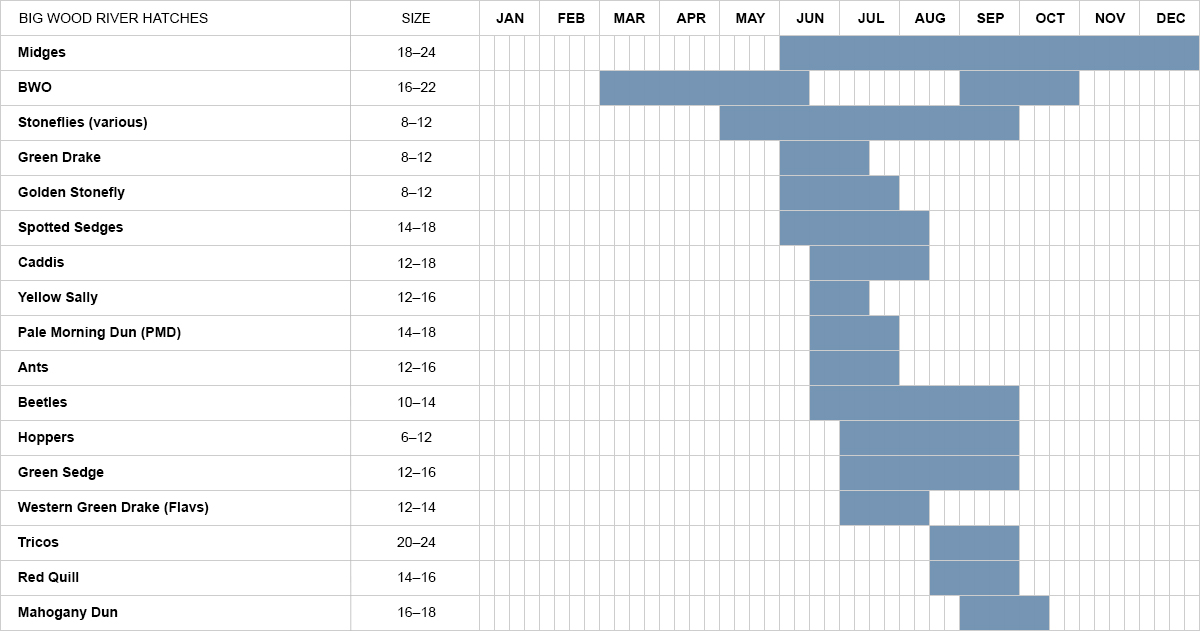The 137 mile Big Wood River in central Idaho is one of the state’s premier fisheries for Brown, Brook, Rainbow and Redband Trout. The following hatch charts list the main fly hatches and aquatic insects anglers should focus on when trout fishing on Big Wood River.

The hatch chart below lists the major mayfly, caddis and stonefly hatches that regularly occur on Big Wood River along with recommended fly sizes and hatch dates. Hatch sizes and dates may vary due to annual fluctuations in water temperature and conditions.
| Fly Hatch | Size | Date |
|---|---|---|
| Midges | 18 - 24 | Jan 1 - Dec 31 |
| BWO | 16 - 22 | Mar 1 - June 15; Sep1 - Oct 31 |
| Stoneflies (various) | 8 - 12 | May 1 - Sep 30 |
| Green Drake | 8 - 12 | June 1 - July 15 |
| Golden Stonefly | 8 - 12 | June 1 - July 31 |
| Spotted Sedges | 14 - 18 | June 1 - Aug 15 |
| Caddis | 12 - 18 | June 15 - Aug 15 |
| Yellow Sally | 12 - 16 | June 15 - July 15 |
| Pale Morning Dun (PMD) | 14 - 18 | June 15 - July 31 |
| Ants | 12 - 16 | June 15 - Sep 30 |
| Beetles | 10 - 14 | June 15 - Sep 30 |
| Hoppers | 6 - 12 | July 1 - Sep 30 |
| Green Sedge | 12 - 16 | July 1 - Sep 30 |
| Western Green Drake (Flavs) | 12 - 14 | July 1 - Aug 15 |
| Tricos | 20 - 24 | Aug 15 - Sep 30 |
| Red Quill | 14 - 16 | Aug 15 - Sep 30 |
| Mahogany Dun | 16 - 18 | Sep 1 - Oct 15 |
Major Fly Hatches on Big Wood River
Aquatic insects are plentiful on the Big Wood River and trout have plenty of food to pick from. Paying attention to what trout are feeding on at any given time and matching the hatch, or what is about to hatch, with a good imitation is key to getting trout to bite. Mayflies, stoneflies and caddisflies are the most plentiful hatches.
Blue-winged Olives (Baetis) are about the most consistent hatches that occur. They appear in March and peak in mid June then return during early fall and continue through November.
Green Drakes (Flavs) begin hatching in June and continue through mid July. The smaller Western Green Drake begins hatching in July and hatches continue through mid August.
Pale Morning Dun (PMD) hatches start in mid June and continue through July. PMD hatches are one of the more consistent hatches on Big Wood River.
Tricos enter the scene toward the middle of August and last through mid September. Great Red Quill hatches typically occur right on top of trico hatches.
Mahogany Duns begin hatching the beginning of September and are one of the last major hatches of the season. Mahogany Dun hatches provide excellent fishing the entire month of September.
Stoneflies are an important part of a trout’s diet on Big Wood River. A variety of stoneflies hatch from spring through fall. The most important hatches are Golden Stoneflies (May-October) and Yellow Sallies (June-July).
Caddis hatches are also prolific. Spotted Sedge are the most abundant of the caddisfly hatches. They last from June through August. Green Sedge hatches are only slightly less plentiful. They start in July and run through late September early October. Green Sedge larvae (Green Rock Worms) are plentiful year round. Short-horned Sedges and other species of caddisfly are much less abundant.
Midge hatches occur throughout the year and are prolific during the winter months. Imitations of midge larvae, pupae and adults will produce bites year round but are preferred by anglers during the winter months when hatches are scarce.
Terrestials, including grasshoppers, ants and beetles become an important food source for trout in year July. Hopper, ant and beetle imitations are effective through the end of September.
Streamer imitations of sculpin, minnows and baitfish produce good catch rates the entire season.



